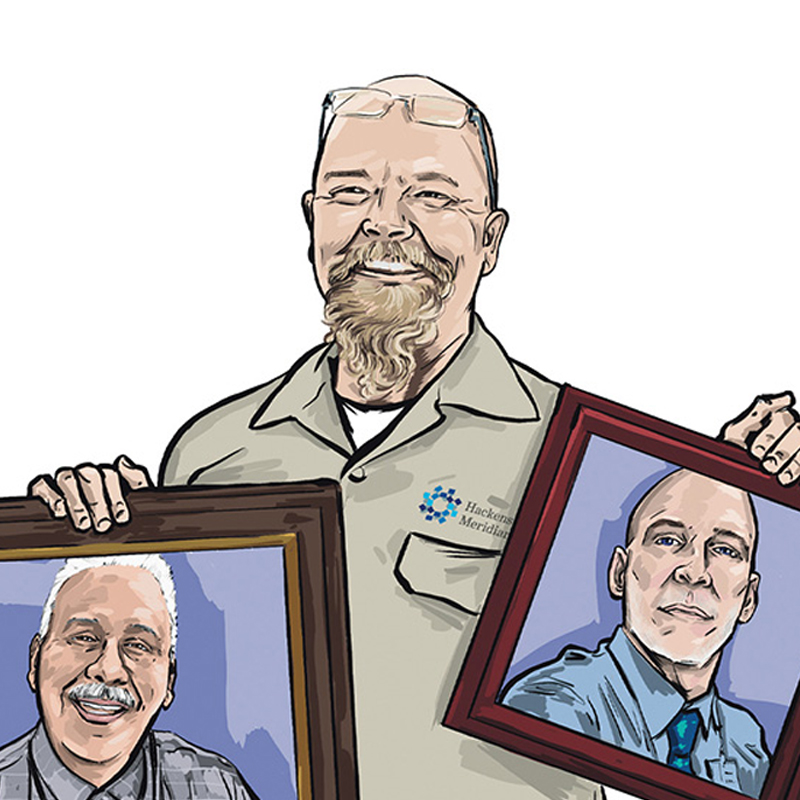Jersey City Man Back in the Gym After Angioplasty and Stenting

October 13, 2023
Carlos Mercardo, of Jersey City, was sitting comfortably on his living room sofa one day in 2010 when he suddenly felt as if he were being punched in the neck.
Precariously driving himself to the hospital, he remembers his doctor saying during an exam, “You’re in trouble, buddy.”
He was indeed. Carlos ultimately underwent coronary artery bypass grafting (CABG) surgery to reroute blood flow to bypass his narrow or blocked arteries.
That procedure was successful. Carlos retired from work, and for 12 years, he lived a relatively normal life. Still, his weight hounded him, once as high as 330 pounds. He also developed type 2 diabetes and still takes medication for that condition.
Tiny Device Lightens Heart’s Workload
In 2022, 10 years after his bypass surgery, Carlos—now age 55—began experiencing sporadic chest pain and shortness of breath. He chalked it up to his weight gain. He made a steadfast commitment to exercise, but he found that working out only worsened his symptoms.
At one point, his legs began to swell and he developed exertion chest pains, prompting him to go to a local hospital. There, tests revealed he’d suffered a mild heart attack and a diagnostic angiogram performed by his cardiologist showed multiple blockages with occlusion of his bypass grafts.
Carlos was diagnosed with complex multi-vessel disease, contributing to a severely compromised pump function of his heart. This prompted his cardiologist to refer him to the advanced interventional cardiology and surgical team at Hackensack University Medical Center for further evaluation and treatment.
Carlos’ heart’s left ventricle was only pumping out, with an ejection fraction of 25 to 30 percent. Ejection fraction refers to the measure of blood the heart’s left ventricle pumps out to the body with each heartbeat. A normal ejection fraction is 55 to 60 percent or higher, and one that is below 40 percent means a heart may be failing.
Carlos was ultimately transferred to Haroon Faraz, M.D., an advanced interventional and endovascular specialist, Director of Interventional Cardiology at Hackensack. Carlos’ clinical case was discussed extensively at Hackensack’s advanced interventional and surgical multidisciplinary team. This team includes interventional cardiologists, cardiothoracic surgeons, advanced cardiac imaging experts and general cardiologists.
The team’s consensus—taking into account Carlos’ prior surgical history, weak heart muscle and complex native coronary anatomy with occluded bypass grafts—was to refer him for high-risk coronary intervention. The team, led by Dr. Faraz, Pranaychan Vaidya, M.D., and Ankitkumar Kirankumar Patel, M.D., determined that Carlos required angioplasty or stenting, the placing of small mesh tubes, like scaffolding, to help clear his arteries. Because of his weak heart muscle pump, Carlos was approached to participate in a cutting-edge clinical trial called Protect 4 looking into using a heart pump for supporting the procedure.
This clinical trial is assessing the use of a mechanical pump called Impella CP, which is used temporarily during the fixing of blockages to support the heart muscle pump. The pump is the world’s smallest pump, which lightens the workload of the heart, maintaining patients’ blood pressure and heart flow during fixing of complex blockages. At the end of the procedure, once the blockages are fixed, the pump is removed from the body.
Unwavering Commitment to Fitness
Two days after his procedure, Carlos was home with his family. Today, he feels like he has a new lease on life, and he’s lost more than 60 pounds. He tracks his fitness on an app and drinks lots of water. He’s also eating smarter, monitoring portions and keeping a watchful eye on his sodium levels.
He says his energy level has improved and he alternates between stretching, cardio, strength training and swimming, several times a week at his gym. With appropriate medications for his weak heart muscle, along with fixing the blockages and modifying his diet and lifestyle, his heart function has improved from 25 to 45 percent.
“Bread is still my downfall, but I eat one slice of toast a day, and I top it with a healthy butter substitute,” he says.
Carlos treasures time with his family and volunteers to work in the family floral business, doing a variety of customer-facing tasks. He’s also committed to local charity work in his community.
“I want to live a content, happy life that’s authentic,” says Carlos, who has future plans of traveling the world.
Next Steps & Resources:
- Meet our sources: Haroon Faraz, M.D.
- To make an appointment with a cardiologist near you, call 800-822-8905 or visit our website.
- Learn about our cardiology services
- Get screened for heart disease
The material provided through HealthU is intended to be used as general information only and should not replace the advice of your physician. Always consult your physician for individual care.





